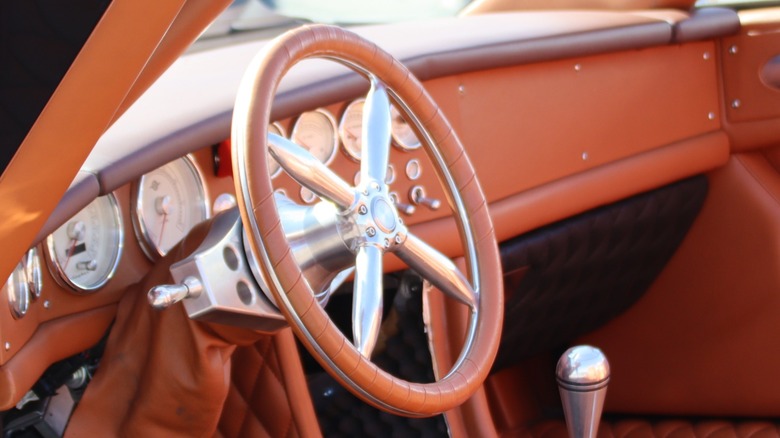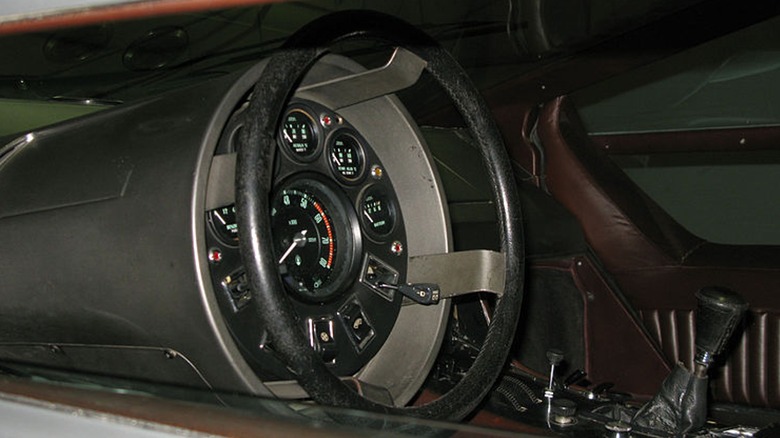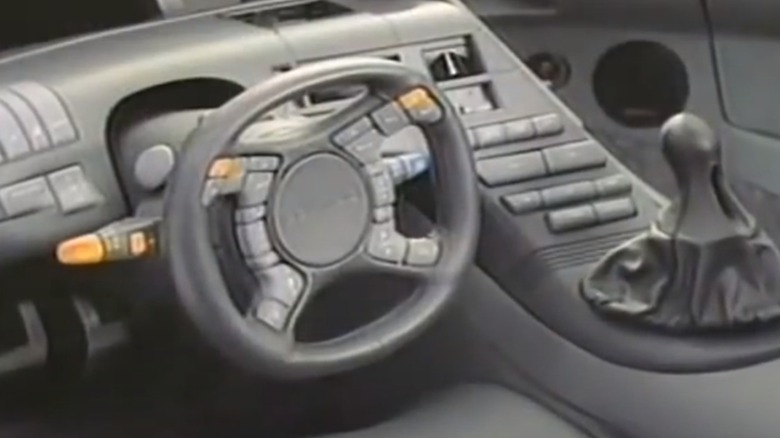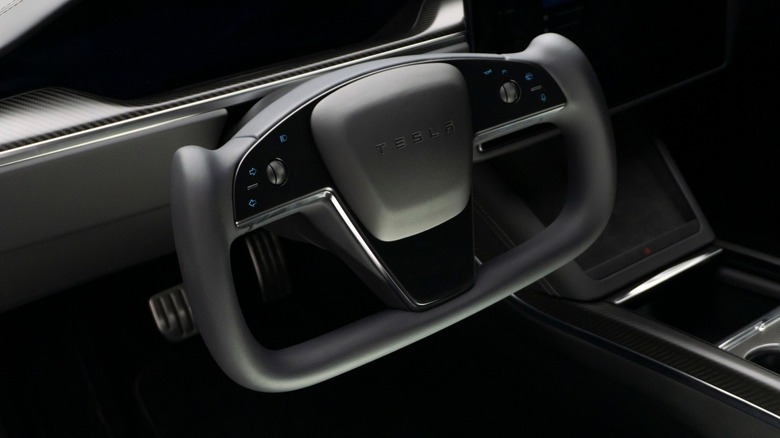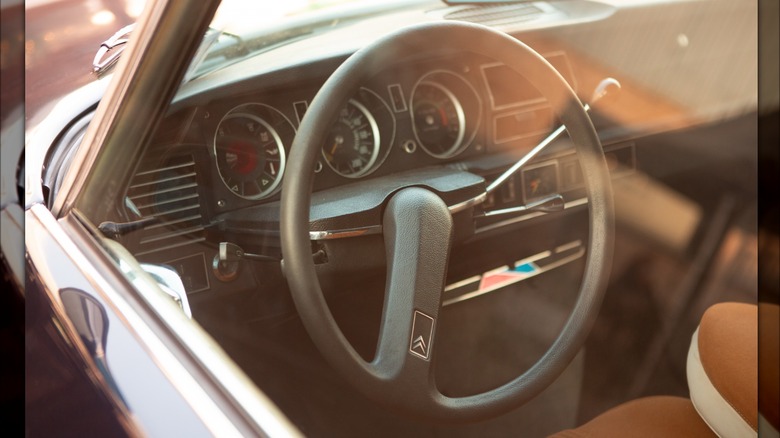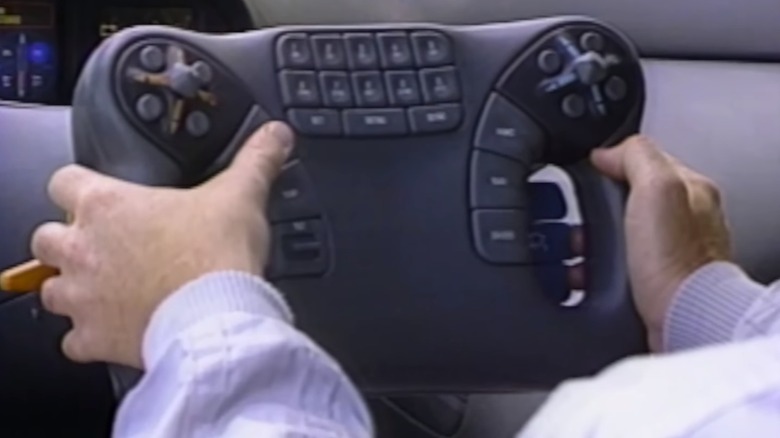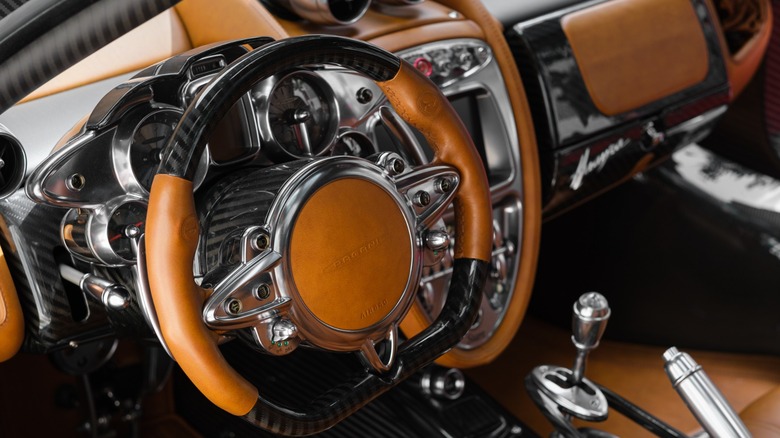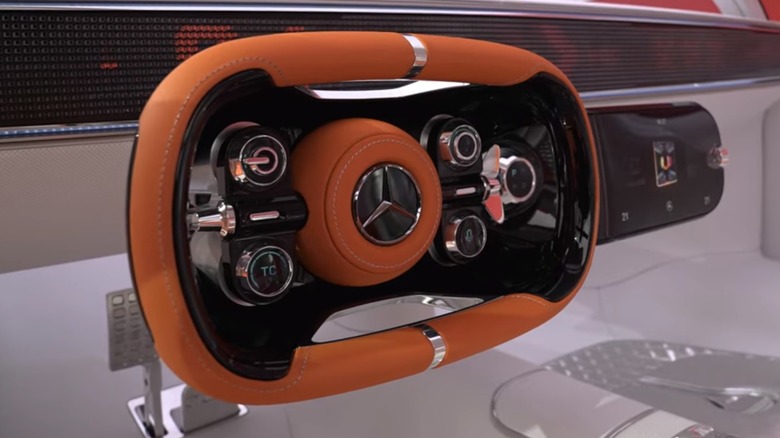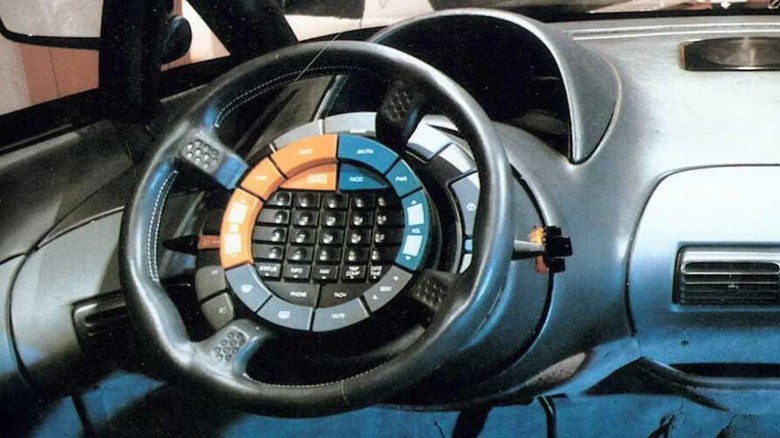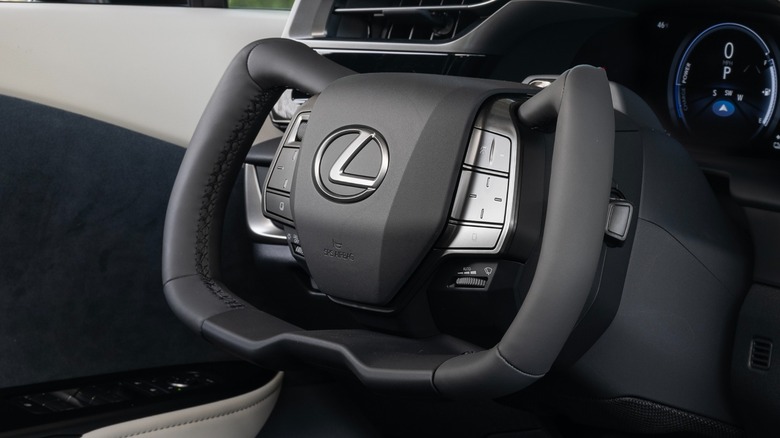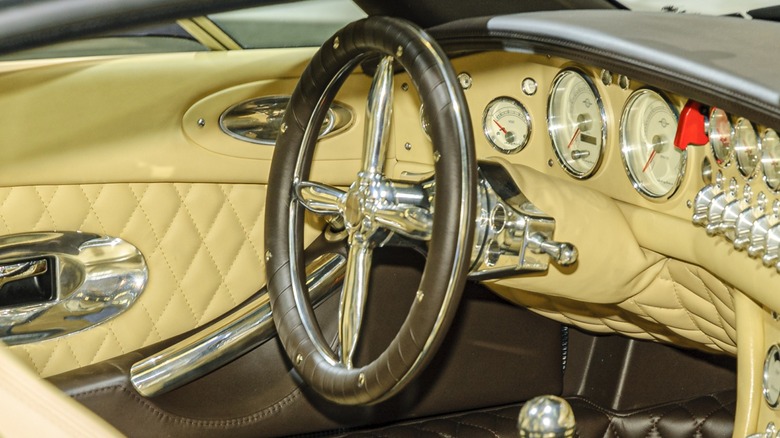10 Of The Coolest Steering Wheels That Went Against The Norm
In every car built — excluding a few experimental concepts — a steering wheel is present and integral to the vehicle's operation. It is such an ordinary and everyday thing you manipulate every time you drive that you probably don't ever give it much thought. However, surely you have noticed among the various cars you have driven that some are fancier than others while some have an ever-increasing number of added functions.
There is no denying the vast array of styles implemented across the ages. Some automakers have sought to make their cars more distinctive by adding superfluous flair while others have integrated more practicality. Vehicles on the lower end of that spectrum come with something that is merely practical and functional. Meanwhile, high-end carmakers have installed wheels meant to be comfortable and connect the car to the driver using luxury materials and ergonomic design.
While these steering wheels have typically achieved the manufacturers' goals, some designers have sought to color outside the lines. Adding multiple functions at your fingertips or simply creating oddly shaped steering wheels have all been placed in both concept cars never meant for public consumption as well as regular everyday production models. Though there are numerous examples of such designs, these are but 10 of the coolest that have ventured far outside of the norm.
Maserati Boomerang
This Italian concept car was born in the early '70s, demonstrating a wild example of the popular wedge car design that also showed up on production cars such as the Lamborghini Countach. Maserati first presented its futuristic Boomerang concept in 1972 at the Geneva Motor Show, stunning guests with its exquisite beauty and futuristic design.
With styling performed by famed Italian designer Giorgetto Giugiaro's firm Italdesign, the Boomerang sat on a Maserati Bora chassis with a 4.8L OHC V8 at the rear. While the exterior shape featured a sharp and forward-thinking design, the interior blended the same styling elements with opulent luxury and modern convenience.
The most peculiar design element rests in a pod on the driver's side that houses the steering wheel as well as all the car's gauges and accessory controls. Even the turn signal and wiper stalks are housed within the circumference of the steering wheel. A large tachometer is the central focus while other engine gauges form an arc to the top. It is a shame this is a one-off car and this was never intended for production. However, with such an odd arrangement, the manufacturing would likely have been too complicated to make it within a reasonable budget.
Fortunately for us, this car still exists and occasionally makes it out to auto shows in Europe, giving us opportunities to gawk and marvel at this strange and beautiful machine.
[Featured image by Herranderssvensson via Wikimedia Commons | Cropped and scaled | CC BY-SA 4.0]
Pontiac Banshee
Pontiac first adopted Banshee as the name for a front-engine coupe in the early '60s under the direction of John DeLorean. However, much to his chagrin, the top brass shelved the program fearing it would diminish the Corvette's position in the market, but the name would be used on successive concept cars. This included the Pontiac Banshee IV in 1988, which appeared at the Chicago Auto Show that year where the aggressive supercar wowed attendees with a futuristic and cutting-edge design.
The exterior displayed a sleek supercar body made of fiberglass that housed a 4.0L 32-valve V8 good for 230 horsepower, a disappointing figure when viewed through modern eyes. However, the interior is where this car excelled. Most notable is the generous helping of buttons to control every accessory and function imaginable, from air conditioning to the movable steering column. The driver's focus on the road is meant to have few distractions by including 20 buttons on the steering wheel, controlling climate control, audio, lighting, and cruise control — features that are common today but were innovative in 1988.
This car is very cool, but it should be apparent to most that it was a styling exercise that would never have been approved for production. However, it seems it helped to guide future Pontiac design, especially considering contemporary Pontiac steering wheels featuring clusters of buttons where horns once resided. However, where the Banshee steering wheel is a good example of style blended with function, the regular production wheels are gaudy and tacky button-filled abominations like the one seen on a 1993 Pontiac Bonneville SE at Curbside Classic.
Tesla Model S Plaid
In general, Tesla has been well-known for thinking outside the box and bringing innovation to cars that few of the legacy manufacturers could possibly endeavor to implement. Being a small tech startup, Tesla has the freedom to build and create unencumbered by multiple layers of management encountered in giant corporations. This has mostly yielded positive developments, including features such as autopilot and Sentry Mode. Nonetheless, sometimes an idea slips through that may seem like a winner and fails to achieve the widespread adoption the company's CEO strives for.
The perfect example of this concept is Tesla's new steering wheel. In reality, it is not a steering wheel at all. It's a yoke similar to what you might find in a small aircraft that was first offered on the Tesla Model S Plaid in 2021. The idea of having a yoke in this particular model makes sense in that the Plaid model designation is a throwback to the top speed of a spacecraft in the 1987 Mel Brooks Star Wars parody film "Spaceballs."
Whether you like the yoke or not, it is an innovative steering wheel design. It does create an unobstructed view of the driver's gauge cluster, which is a definite benefit. However, the Tesla yoke has certainly caused controversy, and some feel certain driving scenarios are compromised, such as at low speeds in parking lots. Whether this is the way of the future for all cars remains to be seen.
Citroën DS
Among the products to come out of Europe after WWII, the Citroën DS could be seen as a shining achievement of French ingenuity and design. While most of the features and components are extraordinarily unorthodox, they come together to form something so totally unique and wonderful that it could only come from one place.
The biggest highlight of the DS is its innovative hydraulic system. It uses a combination of pneumatic and hydraulic components to form a suspension that provides the smoothest ride on the planet. Beyond that, the same hydraulics also operate the clutch, power steering, and brakes. Another quirky but great feature is the steering wheel. While it is a basic wheel with no additional function –- this is still a car from the '50s after all -– the wheel is suspended by a single spoke. Rising up and curving immediately out of the steering column, the single spoke holds the wheel in a way that makes it look a bit like it is floating in front of the instrument cluster.
The steering wheel design leaves a clear and unobstructed view of the gauges but also collapses in case of a collision, making it an early safety feature for the industry. Most of all, it is a bit weird and quirky, and that makes it wonderful.
Pontiac Pursuit
Pontiac apparently had a lot of cutting-edge ideas in car design during the '80s. Some interesting concepts came from the automaker, with some eventually making it into production in some form. The 1987 Pontiac Pursuit, however, was not one of those concepts. Looking more like something from the set of "Robocop" or "Total Recall," the bulbous and pod-like shape of the Pursuit indicates that its designers were going for the cyborg world of the future look. Although Pontiac missed the mark of future prediction by having a gas-powered engine in the rear instead of batteries, at least they got everything wrong on the inside, also.
Not foreseeing the future of cheap and versatile screens in all of our cars, Pontiac designers foresaw a future with the most buttons possible rather than the fewest. The advanced engineering of the Pursuit includes an innovative drive-by-wire steering system utilizing four-wheel steering. It is very sensitive, and the steering input — which is not a wheel, by the way — only rotates 180 degrees left or right. This yoke is outfitted with an array of buttons, including two d-pads used for navigation of the car's onboard computer system, one of the things the designers did get right about the future.
As far as steering wheels go, this one is pretty cool and, at the end of the day, appears to be useful and functional. It even foreshadowed some of the components we have today. The rest of the car is another story.
Pagani Huayra
In the realm of hand-built supercars, few rise to the level of artfulness and advanced engineering as a Pagani. Sprung from the mind of former Lamborghini designer Horacio Pagani, these cars represent machines built with meticulous attention to detail that put engineering and style on equally high footings. The resulting automobiles, the Zonda and Huayra, have quickly become among the most desirable supercars ever built, with retail prices easily exceeding $1 million for recent examples.
For your millions, you receive a vehicle powered by an AMG-built V12 engine producing 800 or more horsepower built from an abundance of carbon fiber to make them lightweight and aggressively tuned for speed. Furthermore, the styling is an exercise in Italian flair, with elegance and opulence seen in no other car.
A Huarya steering wheel is not particularly complicated or peculiar, but it is an elegant piece of hardware. Fine leather covers the hand positions and a center cap while the rest is built from carbon fiber and aluminum, with a few integrated buttons and knobs. The bottom is squared off to make room for the driver but is otherwise conventionally shaped. The highlight of this piece is its aesthetic appeal and timeless beauty. Though modern — it does include an airbag — it still harkens back to the days when luxury cars were all bespoke and built with exotic materials and beauty was the priority above all else.
Mercedes-Benz Vision One-Eleven
Some concept cars come around that obviously have no hope or plan to come to fruition as a production vehicle while others show much promise that, with a few minor tweaks, could soon move through an assembly line. Others, like the Mercedes-Benz Vision One-Eleven prototype, are harder to pin down. Regardless of whether it will become a regular production vehicle, it is a cool electric concept full of novel features that also happened to be incredibly advanced.
Built as a successor and homage to the innovative Mercedes-Benz C111 concept of the 1970s, the Vision One-Eleven advances the ideas of the original with modern tech. It incorporates an electric drivetrain at the cutting-edge of EV technology created in conjunction with AMG, all of which is housed in a rocket-like exterior complete with huge gullwing doors and a glass canopy. Inside is a highly minimalist interior with few pieces of hardware, although Mercedes says the car is equipped with an augmented reality interface to create unlimited possibilities in interior design and function.
The main focal point is its beautiful steering wheel, stitched with orange leather matching the exterior paint. It is shaped in an unusually rounded rectangular fashion. Within are a few large and bold buttons and dials that augment a floating touchscreen and keep everything at finger length. The wheel itself is not so extraordinary in function, but its form is exquisite and exotic. We can only hope our next car will be so equipped with something this attractive.
Pontiac Trans Sport
Many folks who lived through the '90s will remember a trio of vans from General Motors that are often remembered not for being exceptional in any meaningful way but for being shaped like a handheld vacuum. While these unremarkable minivans are largely and rightfully forgotten, they sprang up from a forward-thinking prototype that perhaps should be remembered — the Pontiac Trans Sport concept.
Sometimes, a concept car is shown to the public that shows a lot of promise for what could be an upcoming production model but finally arrives in showrooms as something very different and disappointing. This perfectly describes the Trans Sport. The concept debuted in 1986 looking like a future transport capsule, keeping its passengers ensconced in a sleek and sloped exterior with a couple of giant — but unbelievably cool — gullwing van doors. Sadly, none of the cool factor made it to dealer lots.
The steering wheel is particularly interesting. It looks like it was modeled after the wheel of the Maserati Boomerang concept, composed of four spokes with the center completely covered by controls for various functions of the car. The car's driver interface was a CRT screen display in the instrument cluster that drivers would interact with using the many buttons in the center of the steering wheel. In addition, the car was fitted with an onboard computer on the passenger side, complete with a pop-up screen and keyboard. Sadly, it became yet another example of a future concept that missed the mark but left us with an interesting artifact to gawk at.
Lexus RZ450e
The first fully electric EV from Lexus is already available from your local Lexus dealer. It blends some traditional automotive elements with many innovative and cutting-edge features wrapped in the kind of reliable luxury we have grown accustomed to from the brand. Exterior styling is a bit more bold and angular than previous models, while the interior remains more reserved and typical of other current Lexus models. Most aspects of this car are much like any other Lexus with the EV power being the primary difference. Yet, Lexus has chosen to offer a unique steering input — a yoke.
The yoke, according to Lexus, has no physical connection with the steering rack, instead converting all inputs to electrical signals that tell the car how much to turn. This allows a U-turn to be accomplished without a full turn of the yoke, although the input is less sensitive at high speeds. This means you never need to remove your hands from the yoke, no matter how sharp a turn you need to make.
Overall, the design of the Lexus yoke is pretty cool. It also seems to function pretty well, but it remains to be seen if this will see widespread adoption. It just might be that people are not yet ready for this kind of change.
Spyker C8
The Dutch automaker Spyker once built by hand some of the most exquisite mechanical creations on Earth. While they performed well, Spyker cars were always more about style than brute power. This is evident inside and out when examining any of the few cars built. The interiors featured quilted leather throughout along with aluminum switchgear, wood panels, a machine-finished dashboard, detailed trim flourishes, and a trick exposed shifter linkage in the center console. Few exposed plastics can be found on these cars and the highly stylized exteriors display a fashionable design like no other.
Spyker's history originated in the 19th century when Hendrik-Jan and Jacobus Spijker began building horse-drawn coaches before expanding into automobile and aircraft manufacturing. The brothers' original company went out of business after World War I but was revived in 1999 to build exclusive luxury supercars using Audi drivetrains. With the revival, Spyker's aircraft heritage played a role in its design, and you can see many design elements reminiscent of the early days of aviation.
The C8 steering wheel is crafted to resemble a four-blade propeller while the 10-spoke wheels also incorporate propeller blade design. The wheel is made from polished metal with a leather-wrapped rim. It lacks an airbag as low-volume manufacturers could get exemptions at the time, making it possible to create this less safe but elegant and beautiful interior design feature. The steering wheel has no exotic function, nor is it a cutting-edge design, but its homage to aviation and exclusive craftsmanship makes it one of the cooler features found on any car.
